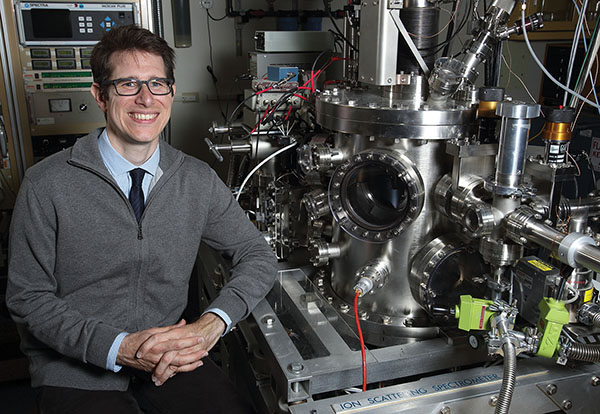Sandia’s Robert Kolasinski wins prestigious DOE recognition for his research

Robert Kolasinski has received a $2.5 million, five-year Early Career Research Program award from the DOE Office of Science. (Photo by Dino Vournas)
Sandia researcher Robert Kolasinski (8366) has received a $2.5 million, five-year Early Career Research Program award from DOE’s Office of Science to support his work on how intense fusion plasmas interact with the interior surfaces of fusion reactors. Robert’s research will develop the scientific foundations needed to determine how reactor surfaces change in harsh plasma environments and to identify mechanisms that limit material lifetime.
“This award provides a great opportunity to lay a foundation for understanding materials for fusion energy,” Robert says. “I am grateful to the Office of Science for this honor and for their support of our work. The next five years will be very exciting.”
Robert’s winning submission, “Characterizing the Dynamic Response of Surfaces to Plasma Exposure,” was selected by the Office of Fusion Energy Sciences, which supports a broad range of plasma physics research activities.
A daunting scientific challenge
“Understanding how materials interact with plasmas is a daunting scientific challenge and presents one of the most significant barriers to the realization of magnetic fusion as an energy source,” Robert says. “My submission seeks to examine the physical mechanisms that govern the evolution of surfaces during exposure to low-energy hydrogen and helium plasmas produced within magnetic fusion experiments.”
Perhaps Robert’s biggest challenge will be to probe surface properties during plasma exposure without having to infer them from post-test analyses. Robert plans to use a variety of experimental approaches, including photon-based spectroscopies, ion beam analysis, and surface science techniques. Those measurements span the broad range of length scales needed to understand how atomic-scale defects evolve into larger defect structures, he says.
In addition to hydrogen plasma-surface interactions, Robert’s research at Sandia examines generally how hydrogen gas interacts with materials. This includes work with metal hydrides, a convenient storage material for hydrogen gas in fuel cell electric vehicles and other applications.
Robert also specializes in a unique surface science technique known as low-energy ion scattering, which precisely analyzes collisions between ions and surface atoms. Ion scattering is one of the only forms of surface analysis sensitive to hydrogen and so can provide insights into rate-limiting mechanisms at material interfaces that affect hydrogen uptake.
Science not an individual endeavor
Robert says he likes to encourage young women and men interested in pursuing careers in science and engineering.
“In addition to having good technical skills and depth of knowledge in one’s field, I think a willingness to build collaborations is essential,” he says. “Science is not an individual endeavor; it is multidisciplinary. A wide range of expertise is required to tackle the most difficult scientific challenges.”
“Working at any of the national labs is a great way to start your career as a researcher. I have been fortunate to work in such a collegial research environment at Sandia with many exceptional mentors. In addition, I also was able to participate in an Early Career Laboratory Directed Research and Development program in my first two years as a staff member that helped me develop some of the experimental techniques that I will be applying to this DOE Office of Science award.”
Robert began his career at Sandia as a postdoctoral Fellow in 2006 and became a permanent member of the staff in 2009. He earned his doctorate from the California Institute of Technology in mechanical engineering. His thesis on spacecraft propulsion — specifically ion-surface interactions in plasma thrusters — was a collaboration with colleagues at NASA’s Jet Propulsion Laboratory. He received his undergraduate degree in mechanical engineering with a concentration in aerospace from Rutgers University.
Robert is one of 49 Early Career Research Program recipients from 22 national labs and 27 US universities chosen by peer review. The goal of the program is to bolster the nation’s scientific workforce through support for exceptional researchers during the crucial early career years, when many scientists do their most formative work.